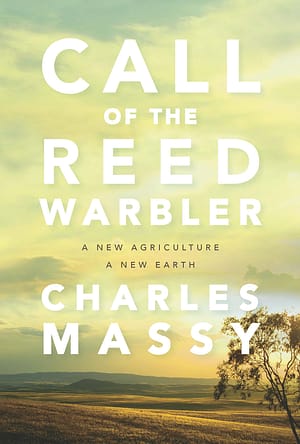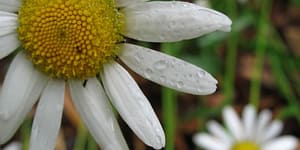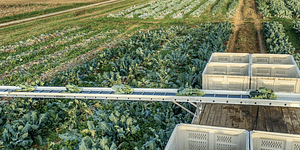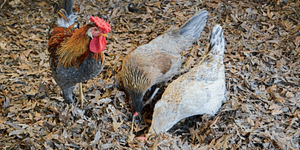Inheriting the Earth

Farmland covers 38 percent of the land area of the Earth and is a major contributor to climate change. But it doesn’t have to be this way. Soil and plants have the capacity to store huge amounts of carbon in the ground, thus how we grow food can be one of the key solutions to our climate crisis.
Visionary farmer and educator Charles Massy argues that an ecologically and socially enhancing agriculture—known as regenerative agriculture—can reverse these harmful carbon emissions by working with nature rather than against it to increase biodiversity, enrich soils, improve watersheds, and strengthen ecosystems.
In this excerpt from his book, author Charles Massy writes about his epiphany about the importance of his farm’s underlying ecology. It has been adapted for the web.
“This is a story for our story-loving species at this most critical of all moments in its entire time on Earth.” —CHARLES MASSY
When my father suffered a major heart attack, I made the decision at the age of twenty-two to return home, take over the farm and finish university part-time. Thus began a forty-year land-management journey. On returning home, I continue developing my interest in birds, mammals and other creatures. However, at the same time I seemed to live a schizoid life. I was quite ignorant about the rest of the insect world, not to mention the arthropod and underground microbial world. In fact, concerning the latter, invisible world, I lived as if it didn’t exist.
Yet this underground component constituted ninety percent of life on the farm. Even more alarming was my ignorance about the vastly more obvious plant world: the very system on which our farming landscape was founded.
Yes, I knew most of the exotic trees and a gum tree or two, and I knew most of our introduced exotic pastures, but I could barely name more than one or two native grasses beyond the most obvious one called ‘corkscrew’ (Austrostipa scabra),and this mainly because corkscrew’s seed penetrated both sheep’s skin and woolen socks just before Christmas.
That is, when it came to farming, I had somehow compartmentalised my keen interest in nature to consider only a few obvious and attractive components. To the rest, I was effectively blind.
Then, one day after a decade or so of management, I was confronted by this blindness. I remember setting off mustering on a horse, my two kelpie sheep dogs trotting behind as we meandered along a two-wheel track through open granite country. This country had once been grassy woodland, and would then have comprised a dominant but scattered canopy of snow gum, candle bark and ribbon gum, plus large blackwood hickories; a scattering of understorey shrubs and forbs; and then diverse native grassland. After earlier phases of clearing, ringbarking, and then more recently set-stocked grazing, all that remained on this day as I mustered were a few dead grey stumps and the odd silver wattle or hickory surviving high up between granite tors and out of the reach of sheep and cattle.
So it was, therefore, puzzling that, as I rode along, I suddenly noticed the strong, sweet smell of what I was convinced was snow-gum blossom. I stopped the horse and looked around, but there wasn’t a snow gum in sight. Intrigued, I circled the horse in a wide arc. Still no snow gums, but the strong blossom scent seemed to come from near a clump of rocks. The only living thing, which partly covered these boulders, was a nondescript dark-green bush that I had barely taken account of previously.

But at that moment, I was intrigued by this nondescript bush because when I bent down, I discovered that it was the source of the overpowering honey-blossom scent. And yes, there, of the most delicate size and shape, were a myriad of little, bell-like pale-yellow flowers hanging upside down within their protective screen of thorns. Clearly the strong, rich honey scent had a purpose, because surrounding the flowers were small native bees, flies, and bright-orange parasitic wasps.
On looking up my reference books, I quickly discovered this nondescript plant was called a tree violet (Hymenantheradentata), otherwise known locally as a gruggly bush. But I did not recognise its importance to an ecosystem nor what its strong scent and attendant insects implied for ecological function. I had been blind to this bush, and it would take time for the blindfold to be fully removed. But I have never forgotten that day, and for me our gruggly bushes are emblematic both of what was lost and also of what could be.
As I travelled further on my journey of ecological literacy, I came to realise the significance of ‘gruggly’ and a myriad of species like it in the vast range of ecosystems across our continent. It is the ‘un-seen’ elements such as gruggly bushes and blackthorn shrubs that provide vital food for animals and insects in a functioning ecosystem. And, suddenly and unbidden, those radical words from the Gospel of Matthew came to mind: Blessed are the meek, for they will inherit the earth.
Recommended Reads
Recent Articles
Oxeye daisies are one of the most important plants for pollinators including beetles, ants, and moths that use oxeye daisies as a source of pollen and nectar. Instead of thinking about removing a plant like oxeye daisy, consider how you can improve the fertility and diversity of habitat resources in your home landscape, garden, or…
Read MoreSo you want to start reaping your harvest, but you’re not sure where to start? Learn how to break down the options of harvesting tools!
Read MoreWhat’s so great about oyster mushrooms? First, you can add them to the list of foods that can be grown indoors! They are tasty, easy to grow, multiply fast, and they love a variety of substrates, making oyster mushrooms the premium choice. The following is an excerpt from Fresh Food from Small Spaces by R. J.…
Read MoreEver heard the phrase, “always follow your nose?” As it turns out, this is a good rule of thumb when it comes to chicken manure. Composting chicken manure in deep litter helps build better chicken health, reduce labor, and retain most of the nutrients for your garden. The following is an excerpt from The Small-Scale Poultry…
Read More








